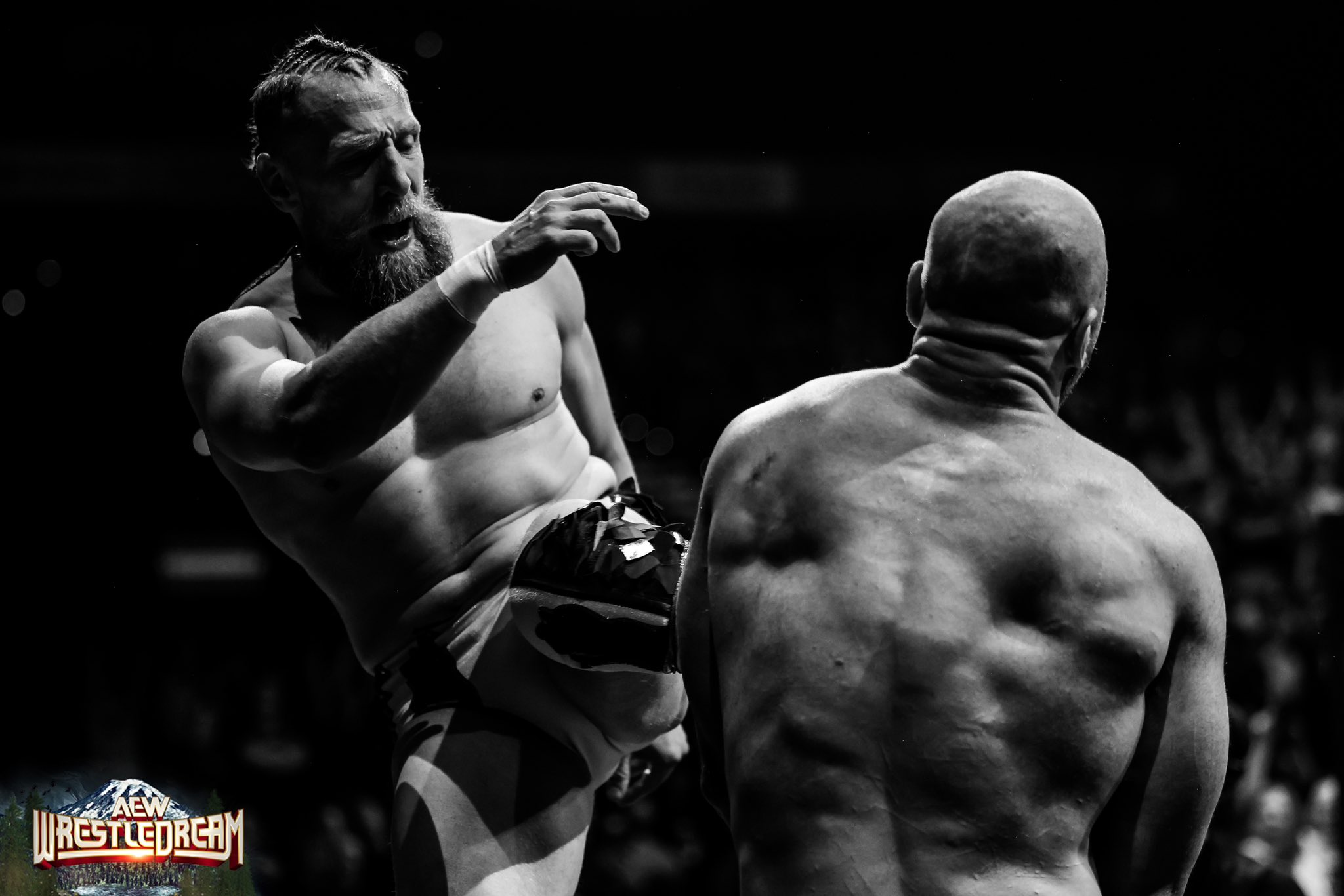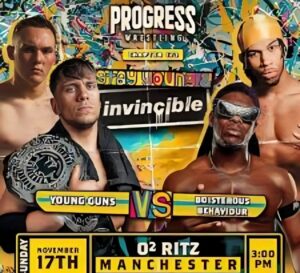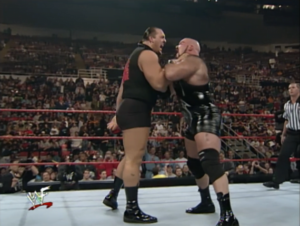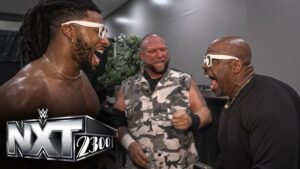Another AEW PPV ends with controversy and attempted murder.
It’s not the first time two rivals in wrestling, let alone AEW, have tried to kill each other on screen. AEW’s use of violence can be visceral, realistic, and upsetting by design.
It can be argued, as I have previously, to be artistic. For “sickos” like myself, the too-far nature of All Out and WrestleDream created an emotive and engaging story with violent splendour.
For others, AEW once again went too far. There is a familiar set of criticisms that hyper-focus on clips and moments. Sometimes stapled on are assertions of why AEW is in “decline”. The “excessive violence is off-putting” narrative.
However, this criticism is myopic. Some of this conversation on wrestler safety, storytelling, and a “lack of butts on seats” ignores and doesn’t care for context.
Double standards do exist. CM Punk clocked Drew McIntyre in the head and left a nasty gash with a toolbox. Their Hell in a Cell match was brutal and awesome. One of the best matches of the year.
Yet very few wrestling personalities or media folks were drawing attention to the risk of head trauma from this spot.
There is a counterargument to this last point and several of the others I’m going to make. These will feature in another article on valid criticism of AEW’s excessive use of violence.
However, looking closely at some of the repeated arguments reveals a hollowness that is symptomatic of wrestling tribalism and beyond.
Why No One Is Thinking of the Children or Casuals
AEW has and doesn’t market itself as child-friendly. Its initial target audience was millennials and lapsed fans. Fans who got hooked around The Attitude Era and Monday Night Wars.
A time when opponents were trying to murder each other frequently on TV. Often in cartoonish and over-the-top ways. The difference in AEW is a more frequent use of realism. Although sometimes AEW has (attempted to) use violence humorously.
Regardless, children do watch and even attend AEW events despite it’s not aimed at them. You see kids on Dynamite dressed in Orange Cassidy and Darby Allin cosplay. Also, as a teacher, I can say kids have seen/shared more gruesome things online than unprotected chair shots and bleeding.
To deny there is a market for realistic violence ignores the success of MMA. It ignores the continual often box-office-proof success of horror movies. The violence of gritty realistic prestige TV shows that target adult audiences.
The idea that you must appeal to casuals and children by neglecting violence to be successful in wrestling ignores history. What AEW has done isn’t new or unique. AEW in spirit is more ECW than WCW.
The company takes inspiration from the NWA, Jerry Jarrett’s Memphis, and FMW. All these promotions used violence to engage audiences, build wrestlers, and tell stories.
In AEW’s beginning and at its peak, when ratings, attendance, and PPV numbers were strong, “blood and guts” did not hurt business. CM Punk vs. MJF heralded as one of the promotion’s best feuds, ended with dog collars and blood.
Even now, despite falling ratings and attendance, AEW PPVs achieve over 100,000 buys per show at $50 a show.
Casual Shift in Attitude
Violence has been part of AEW’s buffet, even before it was a company. “Hangman” Adam Page competed in the first hardcore stipulation match at All In 2018. The first Fyter Fest was headlined by an unsanctioned match.
Which followed a comical attempt at a hardcore match with CEO Gaming’s Alex Jebailey.
The first Dynamite included Jon Moxley spiking Kenny Omega through a glass coffee table. The first Lights Out match happened within a month of the first Dynamite.
From day one, some did not like AEW’s more liberal approach to violence. Former WCW announcer Chris Cruise contacted the Maryland Athletic State Commission because of the first lights-out match.
The company was fined $10,000 in May 2020. Considering the match involved barbed wire, mouse traps, and broken glass, some of the staples of later AEW hardcore matches, the commission penalized AEW for one thing. Intentional bleeding.
Previously Maryland had also fined WWE in 2003 for their No Mercy PPV for featuring an intergender match.
There was less moral outrage and panicking then. My evidence from this: Reddit! Let’s be clear, Reddit is not reliable/credible source for objective facts. But for opinions and a snapshot of how dedicated wrestling fans felt about historic moments, it’s a solid primary source.
The threads I re-read broadly featured positive and joking responses. Many jokes mocked the state commission. In one thread, one user commented on how “very safe” the match seemed gaining over 200 upvotes.
One commenter even pointed out that the fine by the state commission would help the legacy of the match.
Over time, that opinion has changed. Whether in part due to change of feelings about AEW’s creative decline, WWE’s return to form, or other factors.
Sponsors and TV Networks Hate Violence?
WWE went PG to maximize marketing and media profitability. Repeatedly, the sentiment that TV networks and sponsors don’t sponsor violence has been stated but ignores the evidence.
One piece of evidence is repeatedly used: Nick Gage cutting Chris Jericho with a pizza cutter bled into a Domino’s advert. Leading to the pizza giant to threaten and consider removing advertisements afterwards.
Keywords are considered and threatened. Looking at the data, ad effectiveness for AEW generates stronger product engagement than other prime-time shows. Money does talk.
If, violence was this much of a bother to sponsors, why have several companies sponsored AEW hardcore matches throughout the years? Remember the Cracker Barrell Clash at the first All Out? AEW got six figures for a street fight tie-in from SEGA for a videogame tie-in. There was also The Texas Chainsaw Massacre Death Match. Those latter two were more comical affairs.
However, Shark Week sponsored Chris Jericho vs. Eddie Kingston’s Barbed Wire Everywhere match. Warner Bros. Discovery frequently cross-promoted with AEW and has given the company an improved new TV deal. The excessive violence doesn’t seem to bother them.
The Lack of Safety Argument
AEW has been accused (rightly at times, as I’ll discuss in the next article) of not taking wrestler safety seriously enough. Often, the argument focuses on the most visceral and dangerous-looking spots and parasocial assuming a lack of concern for safety.
The needle spot during “Hangman” Adam Page vs. Swerve Strickland is a perfect example. It was real. It was visually horrific, painful, and wince-inducing because many of us have had a dentist shove a needle in our gums.
One of my best friends, a lapsed TNA fan, messaged me after All Out after seeing a clip of the match. During our conversation, I asked her, as a former dental nurse, how safe the spot was.
The answer: nothing is 100% safe. Then again, nothing is 100% safe in wrestling. The needle was real. The cap looked stiff suggesting it was a single-use variety and therefore sterile.
If stuck in the wrong place, it could cause nerve damage to the face. However, if shown by a trained dentist or medical professional how to perform the spot, the risk would be minimal. Stagecraft could have been used to mark the spots where it would pierce the skin and gum to make it safer.
AEW does have a dentist on the roster and other trained medical staff. While founded in some evidence, the assumption that AEW is inherently reckless and careless due to its “indy” style and origins and therefore its wrestlers are more prone to inflicting hurt and injury doesn’t fit the facts.
Injury Myth and Media Bias
Until I researched it for this two-parter article, I also assumed AEW wrestlers were more at risk of injury. It makes logical sense right due to the riskier style and use of violence.
Each time an AEW wrestler is injured, there are various videos, social media posts, and news posts explaining what happened. The comment section echoes the same “common sense” truth/fallacy argument that WWE is safer.
It was only in May of this year that AEW overtook WWE in terms of the percentage of wrestlers out with an injury. 14.9% to WWE’s 12.9%. Both companies have seen in recent times a rise in injuries.
My source for this is The Wrestling Observer, which for some, instantly makes this null and void because of Dave Meltzer’s supposed bias.
Yet at the same time, there is a media bias. To ignore WWE outguns AEW in the media and PR battle ignores that there is some truth to the “AEW is under attack” narrative. Criticism gets amplified for AEW, but questions related to recent issues of talent safety in WWE get ignored.
When Seth Rollins returned at SummerSlam, Rollins was not fully healed. Quickly written off TV, there was little concern. Yes, he returned to be a referee, but there were still risks.
Likewise, few questions have been asked about NXT training methods and why several female wrestlers have suffered ALC tears. Although there are ongoing studies into how in some sports ALC injuries are more frequent in female athletes, there is a pattern.
And if that pattern occurred in AEW, would it be overlooked?
Conclusion – The Right to be Offended and Shocked
It would be disingenuous to say much of the criticism aimed at AEW’s use of violence is overblown or performative. At times it does reflect wider cultural trends of outrage culture to attack/undermine opposition. Yet that would ignore that there are fans who are truly offended by AEW’s graphic violence.
Sometimes AEW’s use of violence and weapons ranges from the farcical and comic to gritty and murderous. What happened at WrestleDream was designed to go far.
Yet it was performative, cooperative, and involved grown men consenting to put their bodies on the line. No different from Shakespeare or a Hollywood film. Intended to shock, it subverted the expectations of a happy ending for a larger storyline purpose.
If someone does not enjoy that story due to being offended, that’s acceptable. They have a right to be offended. At the same time, they also have the right to watch something else. There are plenty of alternatives.
AEW is an alternative to WWE and is not for everyone. Just like in other industries, alternatives with niches can exist, profit, and be safe within reason. AEW has made mistakes in safety and their failure to learn or adapt should rightly be criticised.
What shouldn’t be is the fact there’s not just one way for wrestling to be performed or enjoyed.
If we compare wrestling to cinema, outside of juggernaut mass-appeal studios like Disney exists those who cater to other audiences like A24 and Blumhouse. Each targets a specific audience and their tastes. They know what they have signed up to see.
More From LWOS Pro Wrestling
Header photo – AEW – Stay tuned to the Last Word on Pro Wrestling for more on this and other stories from around the world of wrestling as they develop. You can always count on LWOPW to be on top of the major news in the wrestling world. As well as to provide you with analysis, previews, videos, interviews, and editorials on the wrestling world. You can catch AEW Dynamite on Wednesday nights at 8 PM ET on TBS. AEW Rampage airs on TNT at 10 PM EST every Friday night. AEW Collision airs Saturday at 8pm Eastern on TNT. More AEW content available on their YouTube.





![The Rock Says... Too Much: Overshares in GQ and The Rise of All Access Fans [Photo Cred: GQ/Eli Russell Linnetz]](https://lastwordonsports.com/prowrestling/wp-content/uploads/sites/15/2024/11/gq_dwayne-johnson-gqs-men-of-the-year-interview-300x169.jpg)
